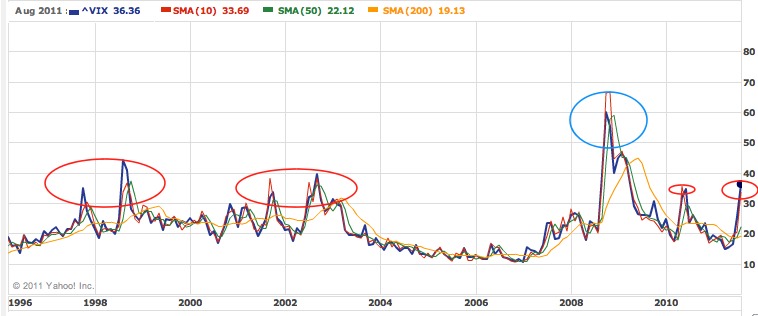Schaeffersresearch.com: bullish. Major indexes held the support levels (SPX above 1100 and 40 month moving average), RUT above 650. VIX is of special interest. Since 1996, VIX at its peaks always represented great buying opportunities (Did you hear news reports of increasing corporate insider buying during this downturn? Those guys know this is a buying opportunity that one doesn’t see often). Another piece of information worthing noting here is that in the 2nd part of Schaeffer’s Monday Morning Outlook, it looked at the Investor’s Intelligence Sentiment Poll, it found the number of bulls actually increased in the week ending Aug. 5th when the stock markets suffered it’s worst 2-week crash since 2008. It then compared to other situations like this and found the intermediate (3 months out) outlook is more bullish than average.
ChartAdvisor.com: cautious. Overall, I like reading Schaeffer’s more than Chartadvisor, because schaeffer’s looks at the market from more perspectives. Chartadvsior is pure technical analysis, with nothing else. I learned a lot from ChartAdvisor.com, though, and I highly respect their technical analysis.
VIX:

VIX Chart (Courtesy of Yahoo Finance) since 1996. With the exceptions of 2008 financial crisis when VIX shot put to much higher than ~40, all the other peaks were ~40. This time around, there is no reason to believe VIX should behavior differently than in the past.
My take: first of all, I sat tight through this difficult time. I actually surprised myself that I remained so calm without any worry or fear, let alone any panicky knee-jerk reaction selling. I have been through many cycles like this. Although every time the circumstances are different, but the pattern is pretty much the same: stock traders got spooked and panicky selling ensued. Then the markets recover, some happy and many sad. Just as I told one of my friends on this topic, markets go up and down. Even bear markets ultimately recover and turn into bull markets. As long as the stocks you chose qualify for my style of investing (Criteria to set up covered call positions), leave them alone. Keep selling time premiums every week, every month or every once a while depending on your situation. This is one sure way to make money. I did, so can you.
I did see the face value of my accounts going lower, however. My account has recovered most of its loss. The only stock that I wish will go higher faster is FFIV (since my strikes are 100 and 105. Therefore there is still quite some room for it to go up to my advantage). I wish I had more buying power now for me to scoop up more shares. This type of buying opportunity happens very rarely (thank God it doesn’t happen more often).
Take home message: It’s a great time to buy stocks you like. But only do so with your hedge (covered calls).

